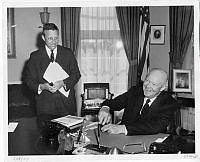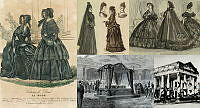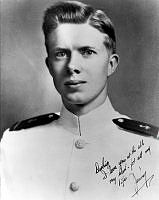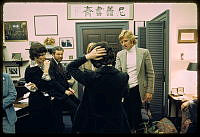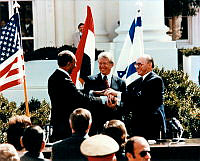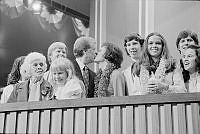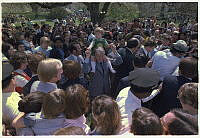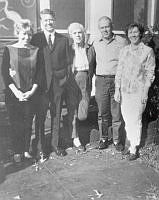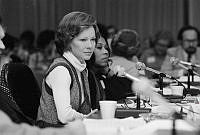Rubenstein Center Scholarship
The Presidential Sweet Tooth
White House Sweets and Pastries for Every Occasion

Ice cream remained a popular White House treat, especially during the summer months. Here, President Calvin Coolidge and First Lady Grace Coolidge eat ice cream at a White House garden party for veterans in 1924.
Library of Congress, Underwood & Underwood CollectionAs the holidays approach, thoughts inevitably turn to sugar plums, gingerbread, and all of the other delectable treats that season brings with it. Sweets signal the changing of seasons and the arrival of holidays, from cookies at Christmas to popsicles in the heat of summer. The same is true at the White House, where presidents and their families have enjoyed spectacular sweets on many occasions.
Until the establishment of the permanent position of White House Executive Pastry Chef in 1979, White House sweets came from a variety of sources. Chefs and cooks played an important part in preparing desserts for White House dinners and receptions, but presidents also turned to outside help for more elaborate confections and pastries. James Buchanan, a bachelor president, entertained with zeal. He hired Charles Gautier, a French caterer and chocolatier, to prepare his 1857 inaugural banquet, and later turned to local caterer Madame Demonet & Sons for his sweets and pastry needs. The Demonet family often catered White House events into the 20th century. “Whenever it is desired to make a good impression upon some foreign potentate or distinguished citizen at the White House,” the Washington Post reported in 1893, Demonet was the firm for the job.1
While the source of White House sweets has changed over time, the presence of delightful confections has remained constant from the earliest days of White House history. President Thomas Jefferson served ice cream, one of his favorite desserts, at a White House Independence Day celebration in 1806. His household administrator, Etienne Lemaire, hired an extra servant to turn the ice cream maker’s crank for the occasion. Ice cream appeared on many of Jefferson’s menus, often served, as one of his guests remarked, “in covers of warm pastry… as if the ice had just been taken from the oven.” In fact, President Jefferson enjoyed ice cream so much that he had an ice house excavated on the White House Grounds, in part to ensure that the chilled treat could be made during the summer months.2

Californian Bill Baker continued to send President Franklin D. Roosevelt Christmas fruit cakes throughout his presidency. The White House received this elaborately decorated cake from Baker in 1939. Brig. Gen. Edwin Watson, a Presidential Secretary accepting the cake from Miss Mildred Cook, Secretary to Rep. A.J. Elliott of California.
Library of Congress, Harris & Ewing CollectionChristmas called for seasonal sweets, and for many years fruitcake and plum pudding were popular White House holiday desserts. Just after the 1912 election, longtime family friend Mrs. John Dodds of Cedartown, Georgia, wrote to future First Lady Ellen Wilson to request the honor of baking the Wilsons’ first White House Christmas cake. Mrs. Dodds made a large, rich fruitcake from a “very rare and much sought after recipe.”3
President Franklin D. Roosevelt enjoyed fruitcake year round and especially on Christmas, and Henrietta Nesbitt, his White House cook, later recalled “December found me up to my ears in fruitcake.”4 She had some help, however, from Californian Bill Baker, who in 1933 sent an elaborate, 110-pound fruitcake to President Roosevelt in time for Christmas. The cake featured sugar decorations representing California missions complete with “sugar palm trees, sugar flowers and sugar mountains.”5 The tradition carried on through the 1960s and 1970s, when Pastry Chef Heinz Bender prepared as many as 180 fruitcakes per year for White House holiday parties.6
White House birthdays and weddings produced their share of delicious and creative sweets. First Lady Mamie Eisenhower had a well-known fondness for the birthday cakes that White House Chef Francois Rysavy prepared specially for her. Rysavy’s rich white cake was flavored with orange liqueur and decorated with pink almond paste flowers, which Rysavy dubbed “Mamie Carnations.” In 1955 the first lady personally wrote to the chef to thank him for the cake, noting that all of her guests “raved over the artistry which you showed in decorating it.” And, she added, “the cake was just as delicious as it looked!”7

President Lyndon B. Johnson looks on as his daughter Luci and her new husband, Patrick Nugent, cut their wedding cake in the White House East Room.
White House Historical AssociationLady Bird Johnson, a well known conservationist, also chose a flower-themed dessert for her daughters’ engagement parties. White House Executive Chef Henry Haller’s “flowerpot sundaes” were served in clay flowerpots, and featured layers of sponge cake, ice cream, and meringue, topped with a fresh flower.8 Fresh lilies also crowned Luci Johnson’s immense wedding cake, a multi-tier masterpiece adorned with crystalline flowers, archways, and swans served at her White House reception on August 6, 1966.9
Sweets and pastries not only have been important to celebrating personal events, but also inauguration receptions and state dinners. At President Andrew Jackson’s infamous 1829 inaugural reception, rowdy guests feasted on ice cream and cake, broke dishes and glasses, and wreaked havoc on the White House in the process. President Abraham Lincoln’s first inauguration ball was a subdued affair, but his second, which took place at the Patent Office, was also the scene of a “terrific crush,” as a large throng of guests demolished the elegant buffet. They had much to choose from – the feast included ornamental pyramids of nougat and caramel, macaroons, almond sponge cake, tarts and pastries, and ice cream in “vanilla, lemon, white coffee, chocolate, burnt almonds, and maraschino” flavors, among other treats.10

Staff work in the White House Family Dining Room to prepare Christmas Yule Log cakes during the visit of West German Chancellor Ludwig Erhard in December 1965.
White House Historical AssociationNot all inaugural receptions would be so elaborate, Franklin D. Roosevelt’s 1945 inauguration took place in the midst of World War II and adhered to wartime butter and sugar rations. White House cook Henrietta Nesbitt consequently served—perhaps to the dismay of President Roosevelt’s guests—practical, unfrosted cakes.11
State dinners honoring a foreign head of state became a White House tradition after President Ulysses S. Grant hosted a lavish dinner for King David Kalakaua of the Sandwich Islands (Hawaii) in 1874. However, the state dinner took on a special elegance and importance to White House entertaining during the John F. Kennedy administration. First Lady Jacqueline Kennedy preferred to serve sophisticated French cuisine, including such desserts as petits fours, chocolate mousse, crème brulée, bombe glacée, and Saint-Honoré cake, which have a cream puff base and velvety cream filling.12
In more recent years, state dinners have often highlighted the cuisine and culture of the visiting guest of honor. Roland Mesnier, who served as the White House Executive Pastry Chef from 1979 to 2004, created unique desserts for each state dinner of his career. For the 1980 dinner honoring Prime Minister Menachem Begin of Israel he consulted a rabbi before preparing a kosher orange sorbet cake topped with dairy-free whipped cream. And when President Miguel de la Madrid of Mexico visited in 1984, he crafted cactuses out of kiwi sorbet, filled them with tequila-flavored mousse, and decorated them with pulled-sugar flowers and spines for a delectable desert-themed dessert.13

Assistant Chef Frank Ruta inspects the cactus shaped sorbet dessert that Chef Roland Mesnier concocted for the 1984 visit of President Miguel de la Madrid and Mrs. Paloma Cordero De La Madrid of Mexico.
Ronald Reagan Presidential LibraryWhite House holidays and celebrations have been accompanied by fantastic sweets and pastries, but presidents do not always need an excuse to indulge in their favorite desserts. President Zachary Taylor, who spent time in Louisiana before his presidency, had a taste for Creole cooking. He introduced the Creole Calas-Tous-Chauds cake, fried and sprinkled with powdered sugar, to the White House. President Theodore Roosevelt also had an impressive appetite and a weakness for sweets. Among his favorites were Sagamore Hill Sand Tarts, named for his Oyster Bay, New York, estate.14 President Ronald Reagan preferred a simpler treat: jelly beans. The Herman Goelitz Candy Company, makers of Jelly Belly, furnished the White House with jelly beans throughout Reagan’s presidency, especially his favorite flavor: licorice.15 Thus, whether they preferred jelly beans or Creole delicacies, fruitcake or chocolate mousse, presidents have had no shortage of ways to satisfy a sweet tooth.

President Ronald Reagan digs into a jar of his favorite jelly beans during a meeting in the White House Cabinet Room in 1981.
Ronald Reagan Presidential Library and Museum/NARA













